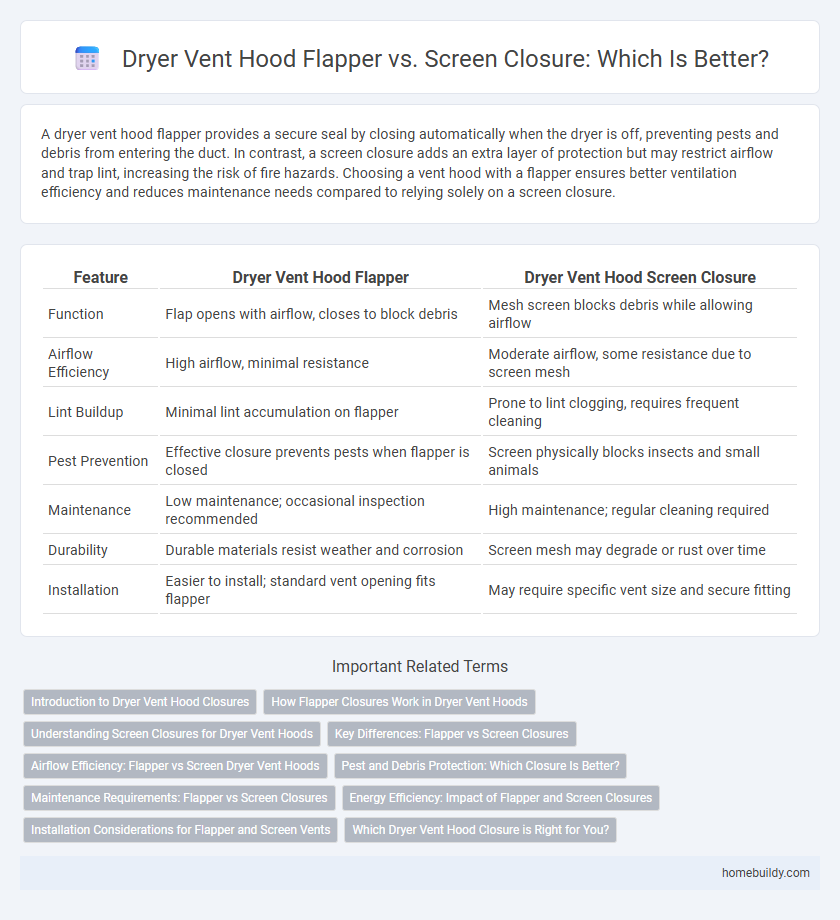A dryer vent hood flapper provides a secure seal by closing automatically when the dryer is off, preventing pests and debris from entering the duct. In contrast, a screen closure adds an extra layer of protection but may restrict airflow and trap lint, increasing the risk of fire hazards. Choosing a vent hood with a flapper ensures better ventilation efficiency and reduces maintenance needs compared to relying solely on a screen closure.
Table of Comparison
| Feature | Dryer Vent Hood Flapper | Dryer Vent Hood Screen Closure |
|---|---|---|
| Function | Flap opens with airflow, closes to block debris | Mesh screen blocks debris while allowing airflow |
| Airflow Efficiency | High airflow, minimal resistance | Moderate airflow, some resistance due to screen mesh |
| Lint Buildup | Minimal lint accumulation on flapper | Prone to lint clogging, requires frequent cleaning |
| Pest Prevention | Effective closure prevents pests when flapper is closed | Screen physically blocks insects and small animals |
| Maintenance | Low maintenance; occasional inspection recommended | High maintenance; regular cleaning required |
| Durability | Durable materials resist weather and corrosion | Screen mesh may degrade or rust over time |
| Installation | Easier to install; standard vent opening fits flapper | May require specific vent size and secure fitting |
Introduction to Dryer Vent Hood Closures
Dryer vent hood closures, including flapper and screen types, play a crucial role in preventing outside elements from entering the duct while ensuring efficient airflow. Flapper closures use a spring-loaded flap that opens during dryer operation and closes tightly to block pests and debris when idle. Screen closures incorporate a mesh that filters out lint and insects but may reduce ventilation efficiency compared to flappers.
How Flapper Closures Work in Dryer Vent Hoods
Flapper closures in dryer vent hoods operate by using a spring-loaded flap that opens when warm air from the dryer pushes through, allowing moisture and lint to exit easily. When the dryer is off, the flap automatically shuts to prevent drafts, pests, and debris from entering the vent system. This mechanism enhances energy efficiency and protects the home environment by maintaining a secure seal while ensuring optimal airflow during dryer operation.
Understanding Screen Closures for Dryer Vent Hoods
Screen closures for dryer vent hoods provide effective protection against debris and pests while allowing proper airflow for dryer operation. Unlike flapper-style vents that rely on a swinging door mechanism, screen closures use a mesh barrier that prevents small particles and insects from entering the vent system. This design enhances ventilation efficiency and reduces the risk of blockages, improving dryer safety and performance.
Key Differences: Flapper vs Screen Closures
Dryer vent hood flappers use a hinged flap that opens when the dryer is running and closes to prevent debris and pests from entering when not in use, ensuring efficient airflow control. Screen closures consist of a mesh barrier designed to keep out lint and insects while allowing ventilation but can sometimes restrict airflow more than a flapper. Flapper closures generally offer better airflow efficiency, whereas screen closures provide enhanced protection against small pests and lint buildup.
Airflow Efficiency: Flapper vs Screen Dryer Vent Hoods
Dryer vent hood flappers provide superior airflow efficiency by opening fully during operation, allowing hot air and moisture to exit with minimal resistance, which reduces drying time and energy consumption. Screen closure dryer vent hoods, while preventing debris and pests, restrict airflow due to their mesh design, potentially causing longer drying cycles and increased wear on the dryer. Choosing a flapper-style dryer vent hood enhances ventilation performance and overall dryer efficiency by maintaining optimal air passage.
Pest and Debris Protection: Which Closure Is Better?
Dryer vent hood flappers provide superior pest and debris protection by automatically sealing the vent when the dryer is off, effectively blocking rodents, birds, and leaves from entering the duct. Screen closures offer a barrier against larger debris but may not fully prevent smaller pests or restrict airflow as efficiently, potentially leading to lint buildup and reduced dryer efficiency. Opting for a flapper-style vent hood enhances both pest exclusion and airflow optimization, ensuring long-term maintenance and safety.
Maintenance Requirements: Flapper vs Screen Closures
Dryer vent hood flappers require regular inspection to ensure the flap moves freely and is not obstructed by lint buildup, which can impair airflow and reduce dryer efficiency. Screen closures demand more frequent cleaning since lint and debris accumulate on the mesh, potentially causing ventilation blockages and increasing fire risk. Both closure types benefit from routine maintenance, but flappers generally offer easier upkeep due to their simpler design.
Energy Efficiency: Impact of Flapper and Screen Closures
Dryer vent hood flappers provide superior energy efficiency by creating a tighter seal that prevents cold air infiltration and heat loss, reducing HVAC workload. Screen closures, while offering protection from debris and pests, allow more air leakage, leading to increased energy consumption. Choosing a flapper closure optimizes energy savings by minimizing unwanted airflow and maintaining indoor temperature stability.
Installation Considerations for Flapper and Screen Vents
Dryer vent hood flappers require precise alignment during installation to ensure the flap closes properly, preventing drafts and pests while allowing optimal airflow. Screen closures demand secure fastening and corrosion-resistant materials to maintain durability and effective debris filtration without obstructing ventilation. Proper sealing and clearance around both flapper and screen vents are essential to maximize dryer efficiency and comply with building codes.
Which Dryer Vent Hood Closure is Right for You?
Choosing the right dryer vent hood closure depends on factors like airflow efficiency, lint buildup prevention, and pest control. Dryer vent hood flappers offer superior airflow and automatically close to prevent backdrafts, while screen closures provide an added barrier against insects and debris but may restrict ventilation and require more maintenance. Evaluating your climate and household needs will help determine whether a flapper or screen closure best balances ventilation performance and protection.
Dryer vent hood flapper vs screen closure Infographic

 homebuildy.com
homebuildy.com